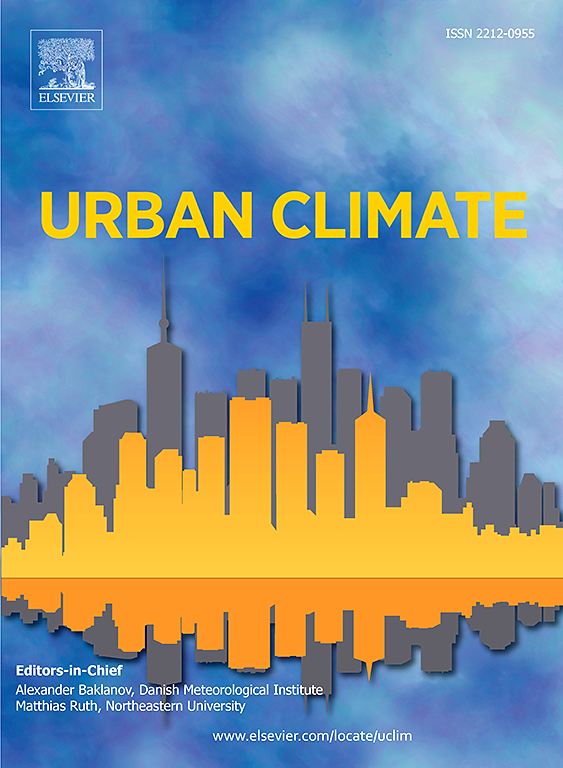多尺度天气预报对达拉斯-沃斯堡都市圈上空冷锋通道期间城市特征和大气条件的敏感性
IF 6
2区 工程技术
Q1 ENVIRONMENTAL SCIENCES
引用次数: 0
摘要
利用自动地表观测系统(ASOS)数据、1 千米中尺度数值天气预报(NWP)和 5 米嵌套大涡模拟(LES)建模条件的组合,研究了微尺度天气建模对大气条件和城市布局的敏感性。分析模式下的 1 千米中尺度预测在风速、风向和温度方面令人满意地再现了观测到的锋面边界时空演变。5 米嵌套 LES 模拟遵循了大尺度强迫趋势,同时由于明确解决了湍流和建筑物之间的相互作用而改进了风速预测。此外,5 分钟平均嵌套 LES 模拟结果显示,时间可变性有所改善,尤其是在锋面过后的强风和湍流条件下。将 1 公里中尺度 NWP 模式预测的技能与粗粒度 LES 场进行了比较。从 5 米嵌套 LES 预测中提取的概率分布对不同气象条件的敏感性最大。与此相反,TKE 的累积分布还明显依赖于特定区域的建筑高度、城市密度和集群的独特分布。本文首次探讨了建筑物分辨率网格间距的集合预报方法设计。与风速相比,TKE 的微尺度集合分布更大,随高度的增加而减小,并受天气条件的影响。本文章由计算机程序翻译,如有差异,请以英文原文为准。
Multiscale weather forecasting sensitivities to urban characteristics and atmospheric conditions during a cold front passage over the Dallas-Fort Worth metroplex
Sensitivities of microscale weather modeling to atmospheric conditions and urban layout are investigated utilizing a combination of automated surface observing systems (ASOS) data, 1-km mesoscale numerical weather prediction (NWP), and 5-m nested large-eddy simulation (LES) modeled conditions. The 1-km mesoscale predictions in analysis mode satisfactorily reproduce the observed spatiotemporal evolution of the frontal boundary in terms of wind speed, wind direction, and temperature. The 5-m nested LES simulations follow the large-scale forcing trends while improving wind speed predictions due to explicitly resolving turbulence and building interactions. Moreover, 5-min averaged nested LES results reveal improved temporal variability particularly during the stronger wind and turbulence post-frontal conditions. The skill of the 1-km mesoscale NWP model prediction is compared to coarse-grained LES fields. Probability distributions extracted from the 5-m nested LES predictions exhibit the largest sensitivity to the contrasting meteorological conditions. In contrast, cumulative distributions of TKE additionally expose a marked dependency on the unique distribution of building heights, urban density and clustering in a given area. For the first time, an ensemble forecast methodological design at building-resolving grid spacing is explored. A larger microscale ensemble spread is found for TKE than for wind speed, decreasing with height and modulated by weather conditions.
求助全文
通过发布文献求助,成功后即可免费获取论文全文。
去求助
来源期刊

Urban Climate
Social Sciences-Urban Studies
CiteScore
9.70
自引率
9.40%
发文量
286
期刊介绍:
Urban Climate serves the scientific and decision making communities with the publication of research on theory, science and applications relevant to understanding urban climatic conditions and change in relation to their geography and to demographic, socioeconomic, institutional, technological and environmental dynamics and global change. Targeted towards both disciplinary and interdisciplinary audiences, this journal publishes original research papers, comprehensive review articles, book reviews, and short communications on topics including, but not limited to, the following:
Urban meteorology and climate[...]
Urban environmental pollution[...]
Adaptation to global change[...]
Urban economic and social issues[...]
Research Approaches[...]
 求助内容:
求助内容: 应助结果提醒方式:
应助结果提醒方式:


